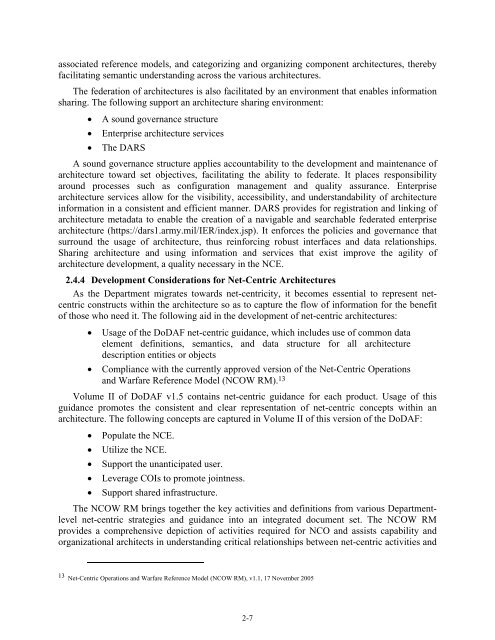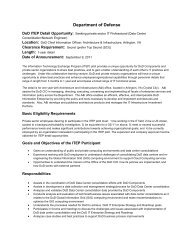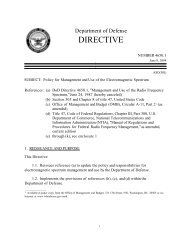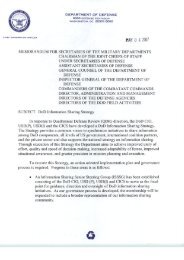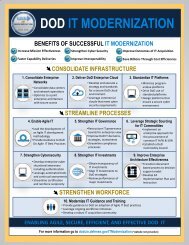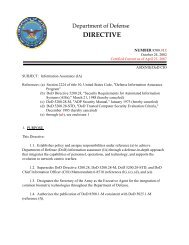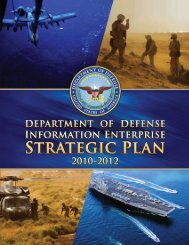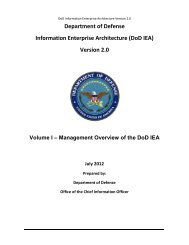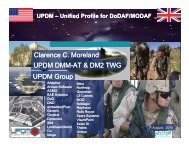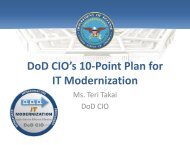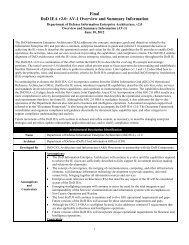DoD Architecture Framework Version 1.5 - Chief Information Officer
DoD Architecture Framework Version 1.5 - Chief Information Officer
DoD Architecture Framework Version 1.5 - Chief Information Officer
You also want an ePaper? Increase the reach of your titles
YUMPU automatically turns print PDFs into web optimized ePapers that Google loves.
associated reference models, and categorizing and organizing component architectures, thereby<br />
facilitating semantic understanding across the various architectures.<br />
The federation of architectures is also facilitated by an environment that enables information<br />
sharing. The following support an architecture sharing environment:<br />
• A sound governance structure<br />
• Enterprise architecture services<br />
• The DARS<br />
A sound governance structure applies accountability to the development and maintenance of<br />
architecture toward set objectives, facilitating the ability to federate. It places responsibility<br />
around processes such as configuration management and quality assurance. Enterprise<br />
architecture services allow for the visibility, accessibility, and understandability of architecture<br />
information in a consistent and efficient manner. DARS provides for registration and linking of<br />
architecture metadata to enable the creation of a navigable and searchable federated enterprise<br />
architecture (https://dars1.army.mil/IER/index.jsp). It enforces the policies and governance that<br />
surround the usage of architecture, thus reinforcing robust interfaces and data relationships.<br />
Sharing architecture and using information and services that exist improve the agility of<br />
architecture development, a quality necessary in the NCE.<br />
2.4.4 Development Considerations for Net-Centric <strong>Architecture</strong>s<br />
As the Department migrates towards net-centricity, it becomes essential to represent netcentric<br />
constructs within the architecture so as to capture the flow of information for the benefit<br />
of those who need it. The following aid in the development of net-centric architectures:<br />
• Usage of the <strong>DoD</strong>AF net-centric guidance, which includes use of common data<br />
element definitions, semantics, and data structure for all architecture<br />
description entities or objects<br />
• Compliance with the currently approved version of the Net-Centric Operations<br />
and Warfare Reference Model (NCOW RM). 13<br />
Volume II of <strong>DoD</strong>AF v<strong>1.5</strong> contains net-centric guidance for each product. Usage of this<br />
guidance promotes the consistent and clear representation of net-centric concepts within an<br />
architecture. The following concepts are captured in Volume II of this version of the <strong>DoD</strong>AF:<br />
• Populate the NCE.<br />
• Utilize the NCE.<br />
• Support the unanticipated user.<br />
• Leverage COIs to promote jointness.<br />
• Support shared infrastructure.<br />
The NCOW RM brings together the key activities and definitions from various Departmentlevel<br />
net-centric strategies and guidance into an integrated document set. The NCOW RM<br />
provides a comprehensive depiction of activities required for NCO and assists capability and<br />
organizational architects in understanding critical relationships between net-centric activities and<br />
13 Net-Centric Operations and Warfare Reference Model (NCOW RM), v1.1, 17 November 2005<br />
2-7


